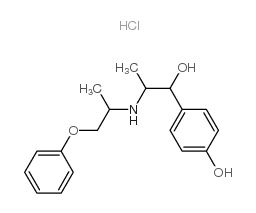579-56-6
| Name | isoxsuprine hydrochloride |
|---|---|
| Synonyms |
Dilavase
suprilent vasoplex Vadosilan Vasotran Divadilan EINECS 209-443-6 Isoxsuprin-hydrochlorid vasodilan isoxsuprine*HCl chlorhydrate d'isoxsuprine Navilox MFCD00058069 Duvadilan isolait |
| Description | Isoxsuprine hydrochloride is a beta-adrenergic receptor agonist with Kis of 13.65 μΜ and 3.48 μΜ for myometrial and placcntal beta-adrenergic receptor, respectively. Isoxsuprine hydrochloride is also a NMDA receptor antagonist. |
|---|---|
| Related Catalog | |
| Target |
Ki: 13.65 μΜ (myometrial beta-adrenergic receptor), 3.48 μΜ (placcntal beta-adrenergic receptor)[1] NMDA receptor[3] |
| In Vitro | Results show that Isoxsuprine hydrochloride inhibits circular chemorepellent induced defect (CCID) formation dose dependently (5 to 60 μM) and also inhibits 12(S)-HETE synthesis. Furthermore, Isoxsuprine hydrochloride is the only drug inhibiting the induction of all three mobility markers (MLC2, MYPT and paxillin)[2]. |
| In Vivo | Total infarct volume in vehicle-treated animals is 279±25 mm3 compare to 137±18 mm3 in Isoxsuprine hydrochloride-treated animals[3]. |
| Cell Assay | MCF-7ALOX12 cells are seeded in 3.5-cm dishes and grown in 2.5 mL complete MEM medium without selection pressure. The next day, the medium is changed to serum-free medium and cells are kept at 37°C for 24 h. Then, cells are treated with 10 μM arachidonic acid and simultaneously with different concentrations of Isoxsuprine hydrochloride for 4 h when the supernatants are aspirated, centrifuged at 2000, r.p.m. at 4°C for 5 min, collected in cryo-tubes, flash frozen and stored at -80 °C until analysis[2]. |
| Animal Admin | Male spontaneously hypertensive rats (SHR) weighing 290 to 300 g are used in this study. At reperfusion, animals receive 0.5 mL of vehicle (0.6% DMSO in normal saline) or 1 mg/kg Isoxsuprine hydrochloride by intravenous (IV) injection through the lateral tail vein. All animals receive 3 mL of subcutaneous saline after surgery to prevent dehydration. After 24 hours reperfusion, animals are sacrificed, brains are sectioned into 4 mm-thick quadrants, and infarcted tissue is identified by 2,3,5-triphenyltetrazolium chloride (TTC) staining. Edema-corrected infarct volume is calculated by subtracting the area of non-infarcted tissue in the ipsilateral hemisphere from the total volume of the contralateral hemisphere. Infarct volume is quantified using Image J software[3]. |
| References |
| Density | 1.146g/cm3 |
|---|---|
| Boiling Point | 484.2ºC at 760mmHg |
| Melting Point | 203-204° |
| Molecular Formula | C18H24ClNO3 |
| Molecular Weight | 337.84100 |
| Flash Point | 246.6ºC |
| Exact Mass | 337.14400 |
| PSA | 61.72000 |
| LogP | 4.06410 |
| Storage condition | 2-8°C |
CHEMICAL IDENTIFICATION
HEALTH HAZARD DATAACUTE TOXICITY DATA
|
| Symbol |


GHS07, GHS09 |
|---|---|
| Signal Word | Warning |
| Hazard Statements | H302-H410 |
| Precautionary Statements | P301 + P312 + P330 |
| Hazard Codes | Xn: Harmful; |
| Risk Phrases | R22 |
| Safety Phrases | 36 |
| RIDADR | UN 3077 9 / PGIII |
| WGK Germany | 3 |
| RTECS | DO8225000 |
